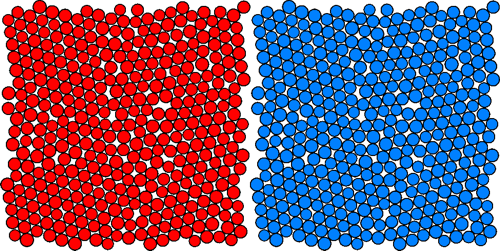Bricks and Inlets
Bricks
A brick is an assembly of particles that may be replicated many times to construct a large model. In a separate PFC run, the brick is derived by creating an assembly of particles within periodic space and then storing it in compact form. Copies of this assembly can then be fitted together perfectly, because the geometrical arrangement of particles on one side of a brick is the negative image of that on the opposite side (see image below).

If the brick is compacted to a desired stress state, a large model may be constructed very quickly because the bricks are already compacted and in equilibrium. (Note that contact forces are also stored within the brick, and these automatically balance at the junction between two bricks if the original forces were in equilibrium.) Typically, the time necessary to bring a model to equilibrium increases greatly with the size of the model, because information (about unbalanced forces) must be transmitted repeatedly across the entire model. When a model is constructed of already equilibrated bricks, no further time is necessary to establish global equilibrium. Thus, a large equilibrated model may be assembled almost instantaneously.
Inlets
The example “Particle Inlets” demonstrates the use of the Inlet logic.
Commands and FISH
| Was this helpful? ... | 3DEC © 2019, Itasca | Updated: Feb 25, 2024 |
